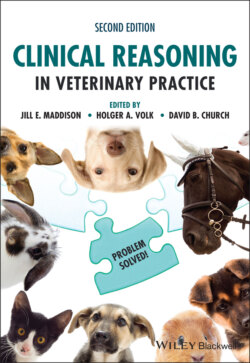Читать книгу Clinical Reasoning in Veterinary Practice - Группа авторов - Страница 22
Pattern recognition
ОглавлениеPattern recognition involves trying to remember all diseases that fit the ‘pattern’ of clinical signs/pathological abnormalities that the animal presents with. This may be relatively simple (but can also lead to errors of omission) and works best:
For common disorders with typical presentations
If a disorder has a unique pattern of clinical signs
When all clinical signs have been recognised and considered, and the differential list is not just based on one cardinal clinical sign and the signalment of the patient presented
If there are only a few diagnostic possibilities that areeasily remembered orcan easily be ruled in or out by routine tests
If the vet has extensive experience, is well read and up‐to‐date, reflects on all of the diagnoses made regularly and critically and has an excellent memory.
Pattern recognition works well for many common disorders and has the advantage of being quick and cost‐effective…provided the diagnosis is correct. The vet appears competent to the client because the vet has acted decisively and confidently…provided the diagnosis is correct.
An example of a case where pattern recognition will invariably be used by most vets and will be successful (most of the time) is Sundance. The differential diagnoses for the pattern of clinical signs – weight loss despite polyphagia associated with polydipsia, altered behaviour and tachycardia – are very limited with hyperthyroidism being the explanation in the vast majority of cases. Score 10 out of 10 for pattern recognition!
However, pattern recognition can be flawed and unsatisfactory when the clinician is inexperienced (and therefore has seen very few patterns) or only considers or recognises a small number of factors (and is not aware that this process is mainly driven by unconscious processes that might need to be reflected upon if they fail). Or even if the clinician is experienced, it can be flawed for uncommon diseases or common diseases presenting atypically, when the patient is exhibiting multiple clinical signs that are not immediately recognisable as a specific disease, or if the pattern of clinical signs is suggestive of certain disorders but not specific for them.
The pattern of clinical signs that Brutus is showing has a much larger range of causes, but it is likely that an experienced veterinarian will recognise several possibilities though often not all. An inexperienced clinician will consider fewer potential differentials.
Differentials diagnoses that experienced vets will consider for Brutus include liver disease, renal failure, hypoadrenocorticism, hypercalcaemia and diabetes mellitus. Routine blood work will be very helpful (provided it is interpreted correctly). Even if the veterinarian hasn’t given a lot of thought to potential differentials (which may hinder discussion with the owner, however), sufficient information may be gained from suitably comprehensive testing (sometimes called ‘going fishing’).
For Brutus the liver enzymes were substantially increased, hypercalcaemia was noted and the final diagnosis was hypercalcaemia associated with hepatic lymphoma (confirmed on ultrasound‐guided biopsy).
The pattern of clinical signs that Erroll is showing are just downright weird, involving different body systems over a period of time and with no ‘obvious’ single explanation for all of the signs even for very experienced clinicians. His bloodwork only showed an inflammatory leukogram. The final diagnosis was a pancreatic abscess and peritonitis from which E. coli was cultured and a urinary tract infection – from which E. coli was cultured.
In addition, for the experienced clinician, the success of pattern recognition relies on a correct diagnosis for the pattern observed previously being reached and not assuming that similar patterns must equal the same diagnosis. Pattern recognition can lead to dangerous tunnel vision where the clinician pursues his/her initial diagnostic hunch based on pattern spotting to the exclusion of other diagnostic possibilities. Several types or indeed combinations of diagnostic bias can result – some examples are shown in Table 2.1.
Table 2.1 Diagnostic biases in clinical medicine.
| Availability bias | A tendency to favour a diagnosis because of a case the clinician has seen recently. |
| Anchoring bias | Where a prior diagnosis is favoured but is misleading. The clinician persists with the initial diagnosis and is unwilling to change his/her mind. |
| Framing bias | Features that do not fit with the favoured diagnosis are ignored. |
| Confirmation bias | When information is selectively chosen to confirm, not refute, a hypothesis. The clinician only seeks or takes note of information that will confirm his/her diagnosis and does not seek or ignores information that will challenge it. |
| Premature closure | Failing to look for additional information after reaching a potential diagnosis and, as a result, narrowing the choice of diagnostic hypotheses too early. |
And finally, the disadvantage of relying entirely on pattern recognition to solve clinical problems means that should the clinician realise subsequently that his/her pattern recognition was incorrect, there is no logical intellectual framework to help reassess the patient. Thus, pattern‐based assessment of clinical cases can result at best in a speedy, correct, ‘good value’ diagnosis but at worst in wasted time and money and, sometimes, it endangers the patient’s life.
